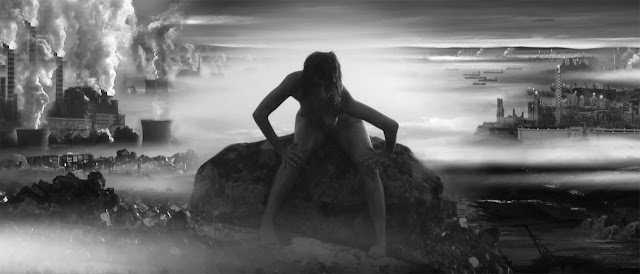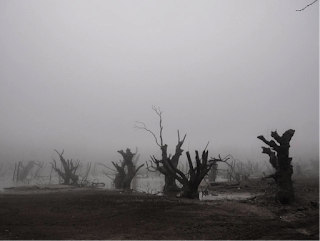In Osmosis
“In particular, today
I would insist on the emergence of post-disciplinary arenas as political
ecology and environmental humanities as an opportunity to go beyond disciplines
and their intrinsic limitation in understanding the current socio-ecological crisis.”
-
Marco
Armiero, KTH Royal Institute of Technology
This is what this blog
has been all about: contributing to this emergent discussion on the importance
of transdisciplinarity and the need for new polyvocal practices and daring pedagogical tools. I have contended with the importance of the
concept of Nature, in particular how we define and imagine it. I have explored its intersections with
disciplines such as art, politics and marketing and with this concluding post I aim to take
this exploration further. There are many fields of knowledge that influence
social and ecological realities. These include – but are not limited to – fashion, religion, philosophy, anthropology, economics, gender studies mental health studies and journalism. In this post, however, I will focus on three
key disciplines associated with climate-induced displacement, one of the
biggest socio-ecological urgencies of this century.
Much like the
undergoing global reshuffle of biodiversity, climate change is going to lead to mass human
migrations. The list is interminable, but some key statistics are the most
shocking:
à Many Pacific
Island nations, such as the Marshall Islands, Kiribati, Nauru
and Tuvalu are disappearing due to rising sea levels.
 |
| Source: https://350.org/350-pacific-we-are-not-drowning-we-are-fighting/ |
à The UN refugee
agency estimates that 22.5 million people have been displaced
since 2008 due to climate-related disasters.
à In 2014 alone 19.3 million people from over 100 countries were forced to
flee their homes due to climate-related disasters (this accounts to basically
one person every second).
And note my use of the
word ‘statistics’. All of these numbers are comprised of people with complex
individual stories, hopes, dreams and ambitions, but the mere shock and awe of
the upcoming mass climate destabilization is expected to bolster the narrative
of dehumanization that these people face.
 |
Graph showing the number and percentage of regional populations effected by drought
|
Law
Despite unilateral
steps taken by some countries to address the impending climate refugee crisis –
such as New Zealand issuing special visas to those fleeing climate disasters and Fiji
investing in a legal framework to relocate those that have been displaced –
there is no international, legally binding agreement on how (especially
developed) countries should mitigate this.
The UN’s 1951 refugee
commission does not recognize climate-induced displacement as
grounds for providing asylum. The concluding agreement of COP21 in Paris does not mention “refugees” or “migration”. The COP23 in Germany set the discussion for climate
refugees, without making any actual tangible progress or setting binding
commitments.
 |
| Source: http://www.ibtimes.com/kiribati-climate-change-relocation-refugee-crisis-sinking-low-lying-island-nations-2127526 |
Global Health
The most comprehensive
report on climate change and health states that “climate
change exacerbates social, economic, and demographic inequalities, with the
impacts eventually felt by all populations”.
à There is a “growing
vectorial capacity for the transmission” of diseases, such as dengue fever, Lyme’s disease,
anthrax, malaria and schisostomiasis.
à By
compromising access to resources such as clean air, water and food climate
change is expected to cause an additional “250 000 additional deaths per year,
from malnutrition, malaria, diarrhoea and heat stress” between 2030 and 2050 according
to the WHO.
Millions of people
facing extreme heatwaves, droughts and floods will be forced to flee their
homes, thus forming new transmission pathways for infectious diseases across migrating
populations and host communities.
These extreme weather
events are diminishing land productivity, thus human societies increasingly
have to shift their focus from expansion to efficiency.
Architecture
From Chinese ‘forest cities’ aiming to curtail air pollution to architect Shigeru
Ban’s ‘humanitarian architecture’ using recycled materials to build effective
and cheap shelters in refugee camps all over the world.
From Ikea’s
renewable-energy-powered refugee settlements to enormous urban farming projects across the world and the tiny house movement in the United States.
21st
century architecture is addressing the most pressing issues of our time, such
as pollution, mass migration, food insecurity, energy efficiency, community-building
and environmental degradation.
It becomes clear then
how different areas of knowledge interact, adapt and evolve in the face of
change. This dynamic relationship between problem-facing and problem-solving is
dispersing across borders both in the natural world and in the human knowledge
collective.
Staying with the…
Trouble! There will be
an immense amount of it in the 21st century. We should allow it to
anger and inspire us, but not incapacitate us. There are many different
socio-ecological struggles around us, each developing with different means but
towards the same end: A more fair, democratic and inclusive society.
Whether it’s composing
a song, running an economic analysis or writing a scientific report we should
delve into this cross-fertilization of disciplines and formulate new and
exciting new languages to address our not-so-new problems until maybe the time
comes when we hear the phrase ‘brave new world’ and we tingle with anticipation
instead of cowering with fear.



Comments
Post a Comment